Aurvana Live! 2
back to Creative
back to measurements
home
Published: Oct-16-2022
NO SMOOTHING is applied to the shown plots. Most measurement sites have some smoothing applied which ‘irons flat’ sharp peaks and ‘wiggles’. I do not use smoothing because some info about sound quality is lost when plots are smoothed.
Aside from a small correction of the microphone itself also some correction in the lowest frequencies is applied to the plots to compensate for the perceived loss of bass when using headphones. This is described HERE in more detail.
A ‘horizontal‘ frequency response curve on the shown frequency response plots on this website thus indicates a perceived ‘flat’ tonal signature.
ALL measurements are made with a good SEAL on a flatbed measurement rig.
The shape of your head, bone structure, pad size, pad ‘softness, (compliance), hair or no hair and or wearing glasses may (drastically) change the frequency response of some headphones, so… your personal experience may differ substantially from these plots.
Frequency response (tonal balance) is the most sound-determining aspect of headphones. A horizontal line shows audible neutral response in the plots on this website. Deviations in different severity at different frequency bands have an effect on the sound character.
The bigger the deviation the stronger the effect.
Below an aid to help determining the sound character of headphones with relation to the frequency response.

Creative Aurvana Live! 2
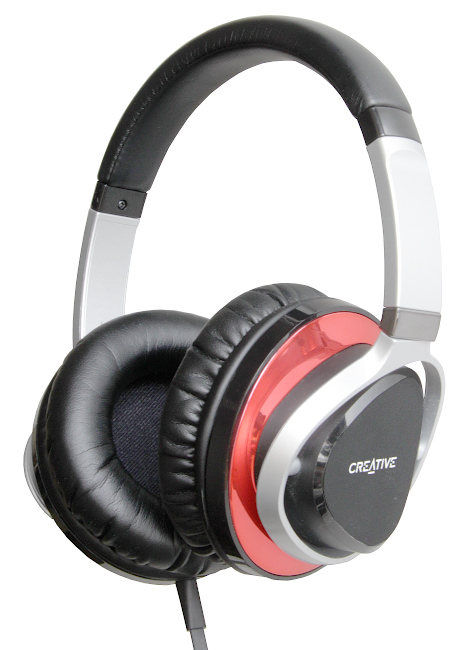
The Creative Aurvana Live! 2 is the successor of the Creative Aurvana Live! which was basically a slightly different finish Denon D1001. These were made by Foster and use the well known Foster bio-cellulose 40mm drivers. It came in a black version (with chrome headband) and black/red version (the one tested here).
When it was released in 2014 it sold for prices ranging between € 110.- and € 150.- and dropped to around € 70.-
This headphone is clearly intended for young people on the go given the impedance, smallish pads, looks and cable with microphone a 1-button remote and volume control. The mic/remote is wired according to CTIA standard to be used with Apple gear. Newer non-Apple phones might well work with this headphone but not all non-apple gear will work well. Also some portable gear with a regular 3.5mm TRS jack might not work properly. The volume control works on all sources and is a 1kΩ potmeter in series with the driver. It has a good range and works well.
The headphone can fold flat for easier transport in the supplied soft cloth pouch.
The headband can extend 30mm. The cups can tilt and swivel far enough for a comfortable fit on most heads. The headrest pleather covered, is small and has some foam inside but one quickly hits hard plastic edges of the headband.
The pads have firm memory foam inside and are covered with thicker vinyl leather look material that feels soft but can become a bit sticky/sweaty on a summer day. The pads can be replaced.
Room for the ears is not plenty (52mm diameter, 21mm depth) but enough for younger to middle aged folks.
The Aurvana Live! 2 has a flat ‘tangle free’ single sided 1.2m cable with a non locking 2.5mm TRRS connector going into the left cup. There is an angled 3.5mm TRRS plug with a CTIA (Apple) 1-button remote + microphone for taking calls and volume control. All connectors are gold plated.
The headphone having a 2.5mm TRRS connector means it can be used with a balanced aftermarket cable. Given its sensitivity I see no reason to have to use this headphone balanced.
The cable is somewhat microphonic. This means touching the cable and it rubbing against clothes is audible in the left cup when no music is playing.
The sensitivity is quite high (120dB/V @ 1kHz but 125dB/V @ 200Hz) so it can play impressively loud even from portable sources like phones etc. Even with EU phones with output power restrictions it can play loud.
This headphone is lightweight (250 gram without the cable) and combined with the medium clamping force (3.5N) makes it a comfortable headphone.
This (modified) headphone is for sale
specifications:
Type: Over-ear, closed
Usage: Home, Portable
Isolation: decent
Driver type: dynamic, bio-cellulose
Pads: replaceable, pleather with memory foam
Inner pad dimensions: diameter: 51mm, depth: 21mm
Collapsible: no, but can fold flat
Headphone connector: 2.5mm TRRS
Cable: 1.2m terminated in angled 3.5mm TRRS with CTIA (Apple) 1-button remote + mic + volume control.
Driver size: ø 40mm
Max. power rating: 1.3W
Max. voltage: 6.5V
Max. current: 190mA
Max. S.P.L.: 130dB
Impedance: 33Ω (measured)
Sensitivity: 120dB @ 1V
Efficiency: 105dB @ 1mW
Weight: 250 g.
Color: black with chrome or black+red and chrome.
Clamping force: medium-low (3.5N)
Accessories: cable with 1-button mic/remote/volume control + pouch
Sound description:
This headphone has substantially elevated bass which is fine for portable usage. The bass is overpowering, bloated or ‘fat’. It gives the headphone a ‘bassy/warm’ sound.
Mids are present but recessed and don’t sound dynamic because of the overpowering lows.
Treble is present and not sharp nor does it sound rolled-off.
Not a sound signature audiophiles will love but fine for people on the go listening to streamed music or youtube. Audiophile people will not like the sound as is but EQ can certainly elevate this headphone to higher levels.
measurements:
Below the frequency response of the CAL2 (left, right)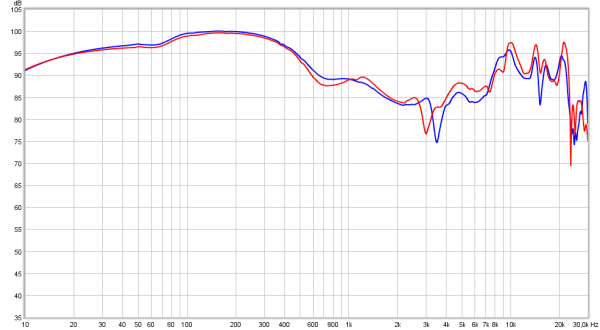
Channel matching is good. There is a substantial bass emphasis below 500Hz. Bass extension is excellent down to at least 10Hz (with a perfect seal). The mids have a very warm tilt to it and voices and instruments sound a bit muffled.
The treble is at the correct level sand not sharp or sibilant sounding.
Below the phase response of the CAL2 (left, right)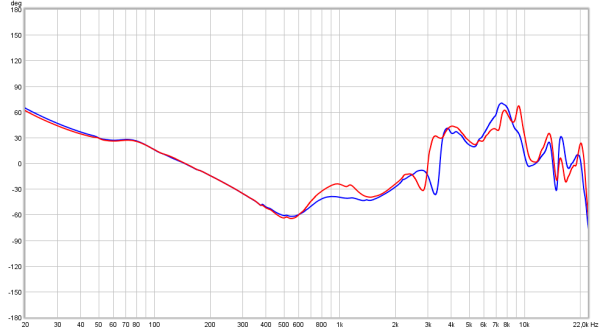
Slow phase shifts are not very audible. Steep changes in a narrow frequency bands may well be audible.
From 4kHz upwards there area few steep changes but the phase shifts are not very big.
Seal
Seal is quite important for closed headphones and this headphone is no exception. As this is an on-ear glasses etc. do not change the seal but hairs and shape of the pinnae become important factors. Below the effect on the sound is shown when the seal is not perfect. The bass suffers. It is the reason why the current pads are bit bigger and wider and softer so they conform better to the shape of the pinna.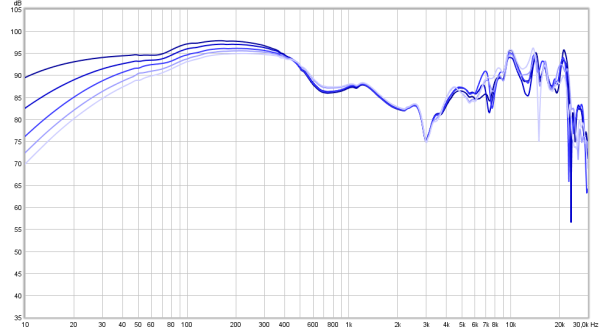
Perfect seal and, in small steps, an increasing amount of leakage right down to seal broken by glasses that are not flush against the skin.
Despite the headphone being closed the loss in bass due to imperfect seal is not that bad.
Comparison
Below the Aurvana Live SE versus the Aurvana Live 2.
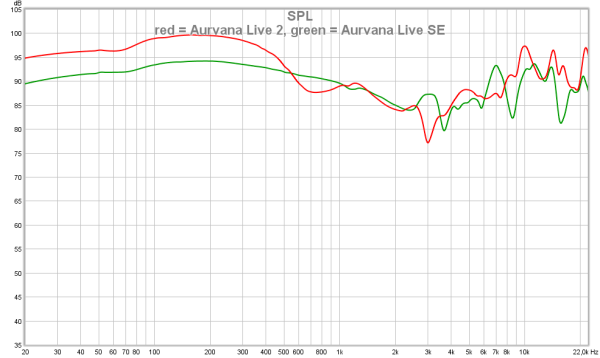
The Aurvana Live! SE is a re-launched Aurvana Live! with a different ‘paint job’
Below, alternating, a comparison between Aurvana Live! 2 and some other over-ear headphones in price classes below and above.
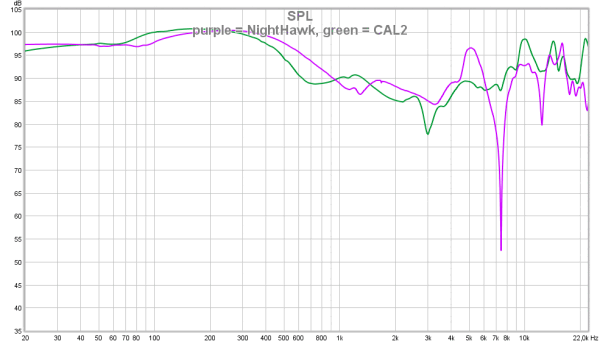
output resistance / damping-factor
As this is a closed dynamic headphone the frequency response can be amplifier output resistance dependent when certain higher output resistance amplifiers are used.
Instead of showing impedance plots, which are hard to ‘read’ when it comes to assessing the tonal balance change in the real world, the Aurvana Live! 2 is measured via a few different resistance outputs (0.2Ω, 10Ω, 32Ω and 120Ω). On a higher output resistance amplifier the output level will be lower of course due to voltage division. To compensate for this the amplifier is turned up to the same level (13.3dB for 120Ω at 1kHz in this case at max. volume setting). This way the plots are overlaid and it is easier to see how the tonal balance changes.  The headphone does not react much to higher output resistances. This headphone thus can be used without having to worry about the ‘1/8th rule’. It will sound very similar from different output resistance amplifiers.
The headphone does not react much to higher output resistances. This headphone thus can be used without having to worry about the ‘1/8th rule’. It will sound very similar from different output resistance amplifiers.
Note: the volume control is a series resistor and is max 1000 Ω at the lowest volume setting.
Below the distortion measurements of the Aurvana Live! 2 (Right channel) at 90dB SPL.
Below the same distortion plot but with the vertical scale in percentages instead of level differences.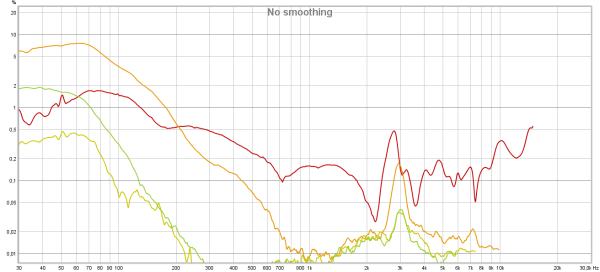 Distortion at 100dB SPL (60 Hz) is quite high (8%) and even worse, it is 3rd and 5th harmonic distortion which is indicative for ‘compression’. Aside from the raised bass levels this kind of distortion is not contributing to good sound reproduction at all. Distortion is quite poor at a bit louder than ‘normal’ listening levels.
Distortion at 100dB SPL (60 Hz) is quite high (8%) and even worse, it is 3rd and 5th harmonic distortion which is indicative for ‘compression’. Aside from the raised bass levels this kind of distortion is not contributing to good sound reproduction at all. Distortion is quite poor at a bit louder than ‘normal’ listening levels.
The 2nd harmonic distortion is probably lower than shown as limits of the test rig are around 0.2%.
At 80 dB SPL (1kHz) the distortion is still on the high side and in the bass mostly 3rd harmonic.
At background listening levels (70dB SPL) distortion is low enough.
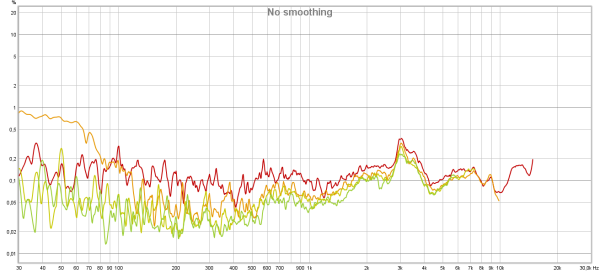
These high levels of distortion is caused by under-damping of the driver, see modification section below.
Linearity
To see how severe the compression is the CAL2 is measured 4 times. Once at 70dB, 80dB, 90dB and 96dB SPL (at 1kHz). Note bass levels are 6dB to 10dB higher.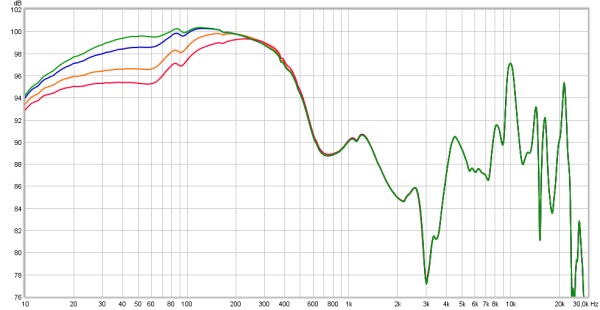 When the traces are overlaid and have the same shape then there is no compression visible. Note the 2dB/div scale. The red trace (96dB at 1kHz) is actually 105dB around 300Hz. There is compression below 200Hz starting from around 75dB or so.
When the traces are overlaid and have the same shape then there is no compression visible. Note the 2dB/div scale. The red trace (96dB at 1kHz) is actually 105dB around 300Hz. There is compression below 200Hz starting from around 75dB or so.
Below the CSD of the Aurvana Live! 2 (Left and Right are overlaid).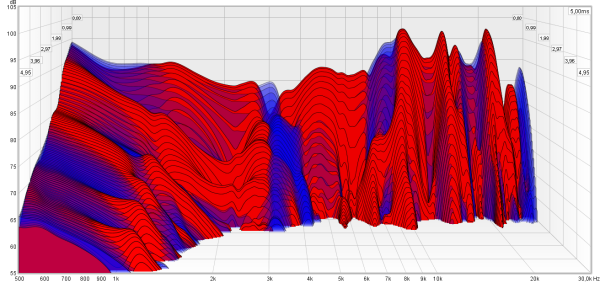 No alarming resonances here.
No alarming resonances here.
Below the spectrum plot of the Aurvana Live! 2 (Right channel). 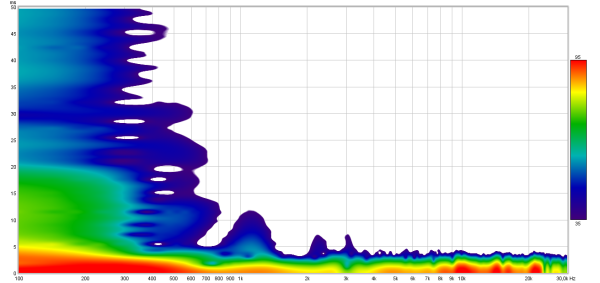 There is some very short lived low level lingering around 1kHz but that is of no importance.
There is some very short lived low level lingering around 1kHz but that is of no importance.
Below the group delay plot of the Aurvana Live! 2 (left, right)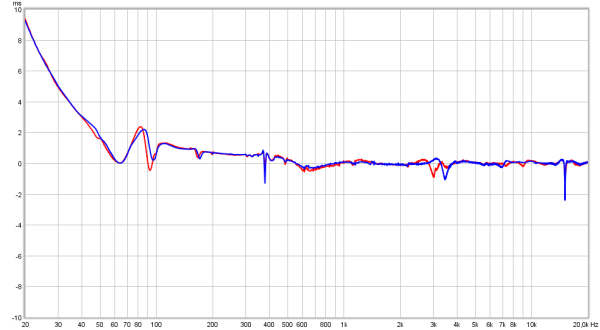
Around 70Hz-100Hz there is some ‘pad bounce’ but this is very small. No issues here.
The step response of the Aurvana Live! 2 (left, right) The initial rise reaches about -10dB and with some small overshoot. The wide peak at around 1ms is indicative of the emphasis in the bass area. The rising part up to 1ms shows the warm/bassy tilt.
The initial rise reaches about -10dB and with some small overshoot. The wide peak at around 1ms is indicative of the emphasis in the bass area. The rising part up to 1ms shows the warm/bassy tilt.
The horizontal part of the trace just sags slowly showing the extended sub-bass extension.
modification
The bass levels of the Creative Aurvana Live! 2 are completely ‘overdone’.
Fortunately there are reversible modifications that can be done that only require a small screwdriver.
The biggest problem is driver damping.
To do these modifications the pads have to be removed. This is quite easy to do as they are just folded over the baffle and are easy to take off.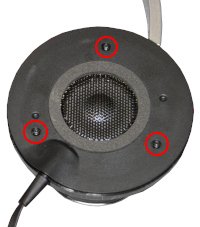
Once this is done the 3 screws in the red circles (on the right) need to be removed. The baffle with the driver can be taken off. Takes a bit of wiggling to remove it. The driver is connected with some wires so do this carefully.
 The wires are long enough so it is possible to turn the driver upside down.
The wires are long enough so it is possible to turn the driver upside down.
On the left the rear of the driver.
There are 2 small holes in the damping paper ring around the driver magnet. These are in the blue circles. The 2 holes in the damping paper around the driver are of no concern (sealing those did nothing).
The small holes in the blue circles need to be closed.
This can be done with any kind of tape.
Below some experiments. Stock (so 2 holes open), 1 hole sealed, both holes sealed.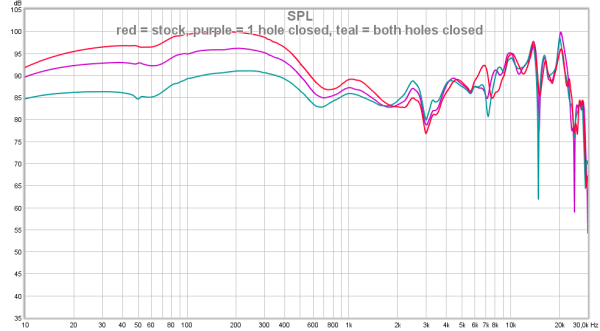 When one feels the bass is too much but does not want to remove much bass (so keep the warm bassy sound) then sealing 1 hole will do the trick. It does not matter which one.
When one feels the bass is too much but does not want to remove much bass (so keep the warm bassy sound) then sealing 1 hole will do the trick. It does not matter which one.
Sealing both holes makes the headphone sound bright/shrill due to the now elevated treble >8kHz. Otherwise tonality is fine.
Another option is to leave the holes open and stuff the space inside the cups with (medical) cotton.
The amount of cotton determines how much bass is lowered. The tricky part is finding out how much and ensuring left and right have the exact same amount. The effect of the cotton is very similar to sealing 1 hole. The more bass is lowered the higher the treble becomes (relatively) as that level is not changed.
The more bass is lowered the higher the treble becomes (relatively) as that level is not changed.
This treble level can easily be lowered with toilet paper. For this one needs soft 3-ply toilet paper.
One needs to cut that into a circle somewhat larger than the driver. The plies of the toilet paper can be pulled apart. Just pull 1 ply off. This gives 2 paper ‘discs’. One is 1 ply thickness and the other one is 2 ply thickness. Below the response of the modification (cups filled with cotton) without any toilet paper, with 1 ply toilet paper and 2 plies toilet paper.
 When using the 1-hole shut modification or the cups filled with cotton 1 ply of toilet paper could be all that is needed.
When using the 1-hole shut modification or the cups filled with cotton 1 ply of toilet paper could be all that is needed.
Below a picture of the drivers, one without toilet paper and the other one with a single ply of toilet paper fixed with some tape on the edges.
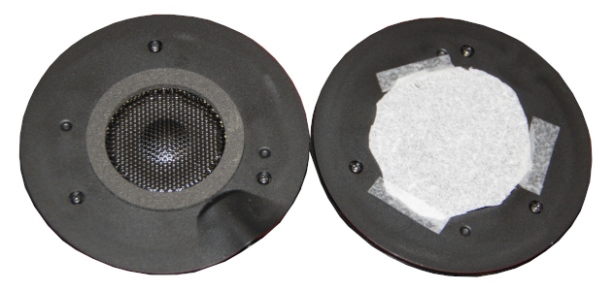
When sealing both holes and using 2 plies of toilet paper one gets the response shown below.

For those wondering why a passive filter was not designed for this headphone the answer is simple, the passive volume control alters the total impedance of the headphone (lower volume = higher load resistance) and a passive filter can only work with a constant impedance.
Both holes closed and 2 plies of toilet paper (so not 2 sheets but 2 plies from a 3-ply sheet of toilet paper) makes a dramatic difference from the stock response.
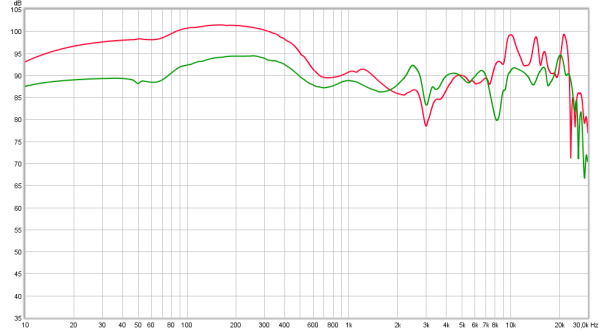
Some extra experiments were done with 1 hole sealed and 1 hole opened up a tiny bit. This is a way of tuning the bass response a bit.
Below the effect of making a small hole (with a sowing needle) in the sealed hole. The hole was sealed with a paper medical tape as it is easy to make a small hole in it. Another experiment was done by partially leaving one hole a tiny bit open (other holes fully sealed). Below (quite enlarged) the hole which is mostly covered and a piece of tape with a pin-hole in it.
Below the difference in frequency response with the configurations shown above.
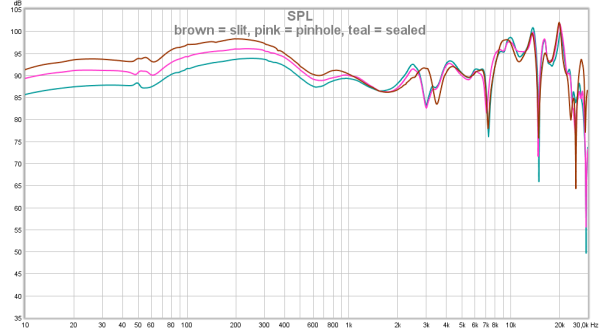 Both holes fully sealed, both holes sealed but 1 hole had a needle puncture hole in it, one hole fully closed and the other hole partly left open (see picture).
Both holes fully sealed, both holes sealed but 1 hole had a needle puncture hole in it, one hole fully closed and the other hole partly left open (see picture).
This way the amount of bass can be ‘tuned’ a little but getting left and right to do the same is a bit tricky with the ‘slit open’ method. Making 2 pinholes reproduces better most likely.
After examining the distortion plots it became clear that with 2 holes fully sealed the distortion was much, much lower.
Below distortion of the stock CAL2
 Below the distortion plot of the same driver but with 2 holes sealed at the same SPL level.
Below the distortion plot of the same driver but with 2 holes sealed at the same SPL level.
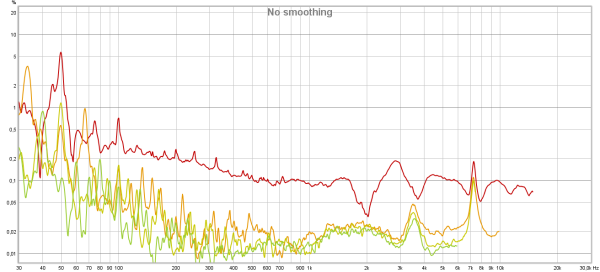 This headphone suddenly had much lower distortion. The most surprising part, however, was that even with both holes sealed and 1 needle pin hole the distortion shot up again to almost the same levels as when the holes were open. (Note: the 50Hz peak = hum and not distortion).
This headphone suddenly had much lower distortion. The most surprising part, however, was that even with both holes sealed and 1 needle pin hole the distortion shot up again to almost the same levels as when the holes were open. (Note: the 50Hz peak = hum and not distortion).
Below some other measurements of the modified CAL2 (both holes closed and 2 plies of toilet paper)
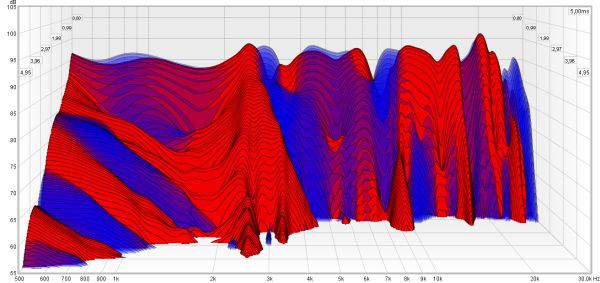 Above the CSD, below the step response.
Above the CSD, below the step response.

The modified Aurvana Live! 2 has a neutral/warmish character with good bass and treble quality.
The tape can easily be removed without damage to the damping paper when medical tape is used.
Also the toilet paper modification can easily be undone if needed and/or other materials can be tried.
This (modified) headphone is for sale
summary
The Creative Aurvana Live! 2 is a closed over-ear headphone with a modern look. The sound is bassy and ‘muddy’ and lacks clarity. Treble is not lacking and of decent quality. A U-shape tonal character but alas a bit too much emphasis above 100Hz to call this ‘interesting’.
Fortunately this headphone reacts well to EQ and modifications are also possible.
This headphone is quite sensitive so can play loud, even from a phone. The microphone, one button remote and in-line volume control and it being a closed headphone makes it quite suited for portable duties on a phone, tablet or laptop.
It is reasonably well made. The cable is removable. The pads can easily be replaced. The headphone is not heavy in weight.
Comfort wise this headphone is decent. The room in the pads is kind of small but good enough for most people below 40 y.o. The pads do get a bit sweaty/sticky on warmer days and the headband padding is a bit thin.
Prices are usually somewhere between $ 80.- and $ 150.-


